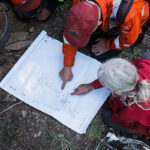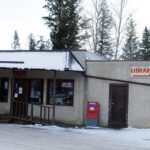Home »

Trip for two, to Florida?
By Jack Loeppky
I’m a genuine hockey fan. At least I thought I was, but it’s been so long since I’ve been close to it, I’m not sure anymore. Small wonder; I’m a Canuck, from around Saskatoon, Saskatchewan and that’s what happens when one leaves home to live in the USA; land of the free and opportunity, in 1967.  That was Canada’s last good year, according to Pierre Berton.
That was Canada’s last good year, according to Pierre Berton.
But I had never seen an NHL game until March 2000 and then, at the age where more is done than remains to be done, I had my first chance.
My son is not a hockey fan. He had never even seen any hockey game; but he was only 19, and there is still time for him to shape up. But he lived in Denver, home of the… ‘Avalanche’ – anybody? He exists in that Purgatory, between high school and college, and out of thin ice, you might say, he suddenly proposed that we go to a real, live, National Hockey League game together.
As a youngster I would have given up a year of anything (but let us say “school”) to have such a chance. The nearest I came to it was when my father made a long train trip – remember them? – across Canada to Toronto. It was the other side of the world, and it was the home of our favorites, the Leafs. I was excited. It was my dream (and his, I’m sure) that he might see a live game. That was my parting wish for him as he boarded the train. It’s not unusual for dreams to fall short in Saskatchewan, and that happened to this one, too. There was simply no game played the day he was there. But he visited Maple Leaf Gardens and to me he seemed bigger when he came back than when he left because of that visit.
None of my former neighbors in ‘Southern’ America really know what it’s like to grow up on the plains of Saskatchewan and live through a loooong, hard, cold winter. During those winters: what to do? One of our Saturday night rituals was listening to Hockey Night in Canada. Listening to that program was a Saturday night ritual in most Canadian homes in mid-20th Century. I can still hear the slightly high-pitched voice of Foster Hewitt, excitedly describing the game.
Hewitt wasn’t the only one. Where we lived, the 7 p.m. radio program captured the voices of Syl Apps, Scott Young and the other members of the Hot Stove League. Between periods, these hotshot analysts made the game more breath-taking for us, sitting around the radio, when they gave their views on the game and the players. Clichés were unknown in those days  because it was ‘fresh.’ Even at the age of three or four (honestly!) Syl, Bill Barilko and Turk Broda meant more to me than any sports hero of today. Hewitt’s excited words brought me right into the games; while on my father’s face was a look of pleasant concentration and approval. He, in turn, described to me who was playing and just what was happening, which was thrilling, because in those pre-school days I was still speaking Plattdeutsch, my native tongue, and all I could hear were the names of my heroes. It was handy to have a father who was wise in the ways of the world and could tell me what was going on in a modern language.
because it was ‘fresh.’ Even at the age of three or four (honestly!) Syl, Bill Barilko and Turk Broda meant more to me than any sports hero of today. Hewitt’s excited words brought me right into the games; while on my father’s face was a look of pleasant concentration and approval. He, in turn, described to me who was playing and just what was happening, which was thrilling, because in those pre-school days I was still speaking Plattdeutsch, my native tongue, and all I could hear were the names of my heroes. It was handy to have a father who was wise in the ways of the world and could tell me what was going on in a modern language.
The game came in on a battery-powered radio while we played hockey on a wooden hockey board my uncle Dave had built. We turned pegs, attached to a board to sock the puck -marble — into the opponent’s goal. And all this — picture it today: by the light of a coal oil lamp, as my mother sat nearby, knitting.
At first I was convinced that the two goalkeepers were the only players, slugging it out. But as our Saturday night ritual continued, I learned the number of players on a team, their names and positions on the ice.
A few years later I moved on from the wooden board inside by the oil lamp to a frozen pond where I remember the thrill of raising the puck while shooting it. This thrill was often dampened by having the puck disappear in the snow banks at the end of the pond.
I progressed to the point where I was spending many evenings practicing at the local rink — wearing my Maurice Richard skates; sometimes I played on the grade school and high school teams, and eventually played in some semi-organized regional senior hockey. I was best as a goalie and even though I had trivial talent and had no serious aspirations for future play, I knew that the game was important as it had something to do with aspirations, effort, perfection and teamwork. Even then I knew these were all vaguely defined aspects of the human condition that we sense, at some time in our life, but never fully grasp.
In the 50s and 60s I followed hockey and knew the good from the bad, the successful from the unsuccessful, teams and players. As for the NHL, with six teams and 120 total players playing 180 games, it was easy to keep tabs. I could follow the changes in and of the game. The wins and the losses were easy to follow and be passionate about because following the sport did not require ‘in-depth analyses’ and interpretations by the puck pundits we have today.
The coming of TV to cover the Saturday night ritual in about 1960, for me, was exciting in a way, but along with that thrill came a vague sense of unease because imagination took a back seat to visual impact. An understanding of the game was no longer required to enjoy it.
But finally here I was, with an opportunity to see a real game, in a place that hardly existed when my interest began, in Denver. It was one of 1,148 played in the ’99-’00 season. That’s spreading hockey a bit thin, isn’t it? But I knew some of the characters in the play for the Colorado Avalanche, formerly the Quebec Nordiques. That team had been the second most disliked — but respected — team of western Canadian hockey fans. This is because they had a great rivalry with the deeply hated Montreal Canadiens and sometimes beat them. That always brought joy to the prejudiced hearts of most Western Canadians. They were to play the Edmonton Oilers. Their greatest claim to fame is that they were a superpower in the 1980s, mainly because of “the great one,” Wayne Gretzky. Obviously they were my favorites because they were Canadians.
In the decades during which I had dedicated myself to school, work and family, I had managed to note the changes in the game, the number of teams and players, the way the game was presented to a multi-media oriented public by the owner-corporations. But the mystique was still there, albeit in the recesses of my mind and heart. Anticipation of the outcome of this game was secondary to the thrill I expected in watching something that was a childhood dream.
I had an inkling of unease when I called the toll-free number for the Avalanche and went through their phone menu; somehow this did not seem to be as it should be. Finally, I connected with a real live human being –lady, and we discussed tickets. In Denver, every game is a sellout; nevertheless, I managed to wangle two adjacent seats “up and back.”
Then I was asked if I would like to know more about a discount for a “trip for two to Florida.” I asked for more information; the ticket lady did not know, but she would connect me with a voice recording. No thanks! I also learned that I could receive automated information about “saving money on the purchase of a new car,” plus a number of other hot deals.
None of this stuff seemed at all related to the urgency I felt about getting seats for my first NHL game. The price was $33 each, and since the purchase required ‘plastic money’ another $10.50 was added for ‘handling fees’ (even though they held the tickets for us), making it $76.50 for the two of us. That’s about as much as I spent on groceries every two weeks. Of course, I could have spent as much as $340.50, but that certainly would have involved a chat with my banker and the seat would have been worse, closer to the ice. Not worth the price.
Upon arriving at the Pepsi Center, about 45 minutes before game-time, we were astonished to see that American football phenomenon, the tail-gating party, with some folks trying hard to simulate a good time. It seemed very much out of character as a preamble for this sort of game.
The first thing we saw upon entering the Pepsi Center and getting to our seats in this very impressive edifice, was a giant plastic (I presume) mountain hanging from the ceiling. I had the same feeling as I did when I heard about the discount for the Florida trip, something clashed. Then began a space age stage production involving a too-loud announcer, the lowering and raising of the mountain intermingled with the entrance through it of game officials, flag bearers and players skating onto and off of the ice, calisthenics by players and referees and many spectators drinking too much beer on the concourse and in their seats, followed by the start of the game, viewed by some 19,000 spectators.
Each had paid from $26 to $165 for a seat, except those in the executive boxes who had paid much more, but would probably gain even more as a result of their investment or philanthropy. I checked these people out carefully with binoculars. In my analysis, they did not enjoy the game to the same extent as the regular customers. It seemed like they were more concerned about the style and color of their cardigan sweaters and seemed to be discussing investment decisions they would make the next day, with cursory glances at the game in progress.
It was a special thrill to see my first NHL game from a vantage point from which I had never seen any game (the third level). From this perspective I was able to appreciate for the first time the intricate teamwork by the two teams in order to advance the puck and defend their zones. The rapid changes with the bench players are also not part of conventional network TV coverage. In my day the defensemen often played 60 minutes and two forward lines changed when they were tired. Here the shifts were 35-45 seconds long and they truly were exhausted when they left the ice each time. Puck handling was absolutely phenomenal and the game was far from the organized chaos portrayed on TV. Breakout plays, zone traps, and defensive systems were quite easy to spot, but I had forgotten them over the years of watching the game as seen by a TV camera and predominantly ignorant announcers.
While I enjoyed the game, other audience members seemed to have starkly different interests and priorities. The fan sitting next to me said, “I don’t know what’s going on, but it sure is great!” There was a giant TV screen hanging over the centre of the ice, adjacent to the mountain. It was definitely the focus of attention and prevented any dull or – thoughtful moments from intruding into the enjoyment of the game. On it was live TV coverage of the game, I suppose for maintaining the interest of fans that could not identify with the real event. There were commercial time-outs, which one does not notice when watching TV at home, because that is when conversations and errands can take place. Also, it allowed much hob-knobbing by the referees and players at their respective benches. Before the game and during intermissions and these timeouts we watched highlights, to music, of savage body checks with dubbed grunting and groaning, while fans cheered wildly (those not drinking or relieving themselves in the crowded washrooms in the concourse). It reminded me of wrestle-mania. There were also highlights of goals being scored (by the home team) and goals being dramatically prevented by Avalanche goalie. We were bombarded with more highlights than one could appreciate in the course of a game. During the game there were replays of the Avalanche goals from every conceivable angle. Famous personalities on the TV also served to get the fans interested in the game–linebacker Romanowski of the Denver Broncos telling us to make some noise (which was done). There were other movie excerpts, which I found very enlightening. Strother Martin, in a scene from Cool Hand Luke, commenting on the “failure to communicate” when the obligatory scuffle broke out between two players and arguments with the linesmen ensued, John Belushi showing what it was like to really go crazy, laughter from Mike Myers to explain the naughtiness of Niinimaa of the Oilers when he got a penalty. John Candy appeared, saying something appropriate and goofy to the game situation. These, and many more clips, all seemed somehow strangely related to “the discount trip for two to Florida.”
After the game, I wanted to be a sports reporter. This would have given me credentials and permission to visit the locker rooms and ask the players whether their recollection of the game matched what I saw, and whether this particular environment and paraphernalia were encountered in every NHL city.
Overall, it was a grand production. The Oilers lost 3-2, the home team was victorious, as mandated by the CEOs, and everyone went home happy, and many drunk.
My son asked if this was what I expected; he seemed slightly disturbed and incredulous by all that he had seen, although it had been interesting, because he had not brought my memories and expectations. I could and would have enjoyed the event more and it would have come closer to meeting my hopes and expectations, if I had not been left behind over the decades by the enlightened corporate producers, as a result of not remaining ‘tuned in,’ as I was some half century earlier. Too much effort had been expended by outside marketing specialists to guarantee that I would have a good time.







